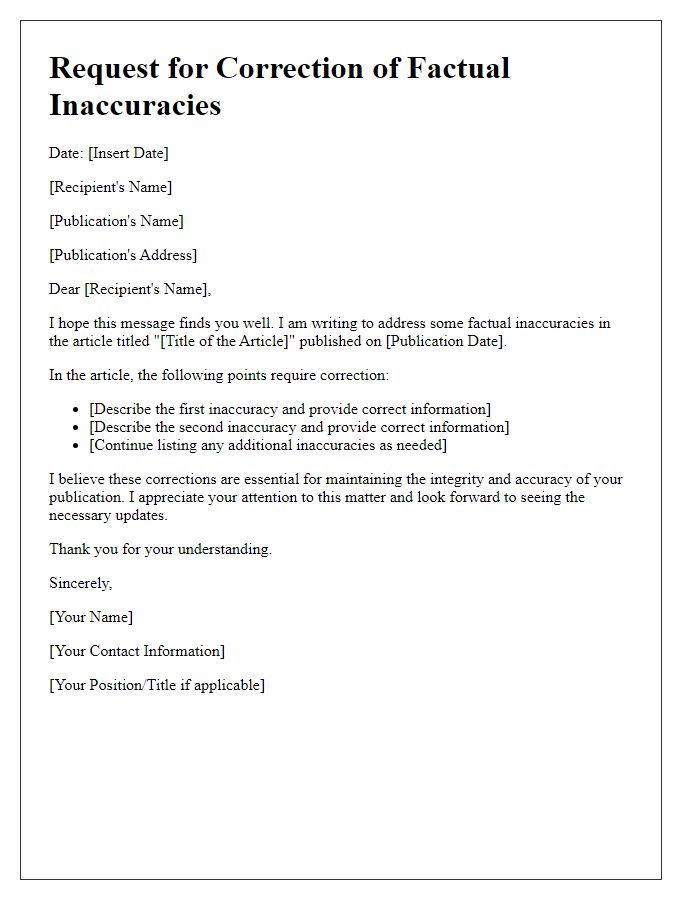In our fast-paced world, accurate information is more important than ever, especially in media reporting. However, mistakes can happen, and it's crucial to address them promptly to maintain credibility and trust with your audience. Crafting an effective letter to request corrections not only helps uphold journalistic integrity but also ensures that the right narrative is shared. Ready to learn how to effectively communicate your concerns? Keep reading for our comprehensive guide on letter templates for media article correction requests!

Accurate Information
Media outlets often publish articles that contain inaccurate information, leading to misinformation. To correct such inaccuracies, individuals or organizations can submit requests for corrections, aiming for transparency and accountability in journalism. Clear identification of the erroneous content is essential. A well-structured request should highlight the specific article, including the publication date and title. Factual evidence supporting the correction, such as statistics, expert testimonials, or primary sources, enhances credibility. Additionally, a respectful tone in communication fosters a constructive dialogue. Prompt inquiries into corrections reflect a commitment to factual integrity, thereby promoting a well-informed public.
Specific Errors
A media article correction request should address specific errors, ensuring accuracy and clarity in reporting. Noteworthy details include publication name, date of the article, and specific phrases or names that require correction. For instance, if an article from The Daily Times published on October 1, 2023, inaccurately states that New York City has a population of 8 million instead of the correct figure of approximately 8.6 million, it should be highlighted. Mention also any implications the error may have on public perception or understanding, such as the effects of demographic data on urban policy discussions. Providing a suggested correction can enhance the effectiveness of the request, promoting responsible journalism and accountability.
Supporting Evidence
A media article correction request typically highlights discrepancies in published information, particularly when it pertains to facts, figures, or quotes. Supporting evidence plays a crucial role in this process, using credible sources to validate the claims made in the correction. Specific examples such as citing official statistics from the Bureau of Labor Statistics or referencing research findings published in peer-reviewed journals can strengthen the request. Notable events, such as a press conference or a public statement from experts, can provide context, while clear indication of the original article--like the title, publication name, and date--ensures the correction is properly contextualized. Accurate representation of the facts not only upholds journalistic integrity but also serves the readers' interest in obtaining reliable information.
Polite Tone
A media article correction request requires clarity and respect in communication, especially when referencing inaccuracies. Politely addressing the editorial team at the publication provides an opportunity to outline specific errors in the article. For instance, referring to misquoted statements, incorrect figures regarding statistics, or errors in attributed sources can ensure the rectification process is clear. Including the article's date and title, along with the specific sections needing revision, allows for precise identification of the content requiring correction. Highlighting the importance of accuracy not just for credibility but to inform readers accurately promotes a productive dialogue. Additionally, expressing appreciation for the role of journalists in delivering news can help maintain a positive tone throughout the request.
Contact Information
Contact information serves as a vital element within media articles, ensuring clear communication and accountability. This information typically includes the author's name, phone number, email address, and possibly the organizational affiliation, aiding readers in reaching out for clarifications or corrections. Accuracy in contact details is crucial, as discrepancies can hinder effective communication. In instances of error, such as misattributed quotes or incorrect statistics, immediate access to contact information allows for swift rectification, promoting journalistic integrity. Furthermore, established practices advocate for transparency by providing a physical mailing address, fostering trust between the publication and its audience.
Letter Template For Media Article Correction Requests Samples
Letter template of media article correction request for factual inaccuracies.

Letter template of media article correction request for misattributed quotes.

Letter template of media article correction request for misleading headlines.

Letter template of media article correction request for incorrect statistics.

Letter template of media article correction request for clarification of context.

Letter template of media article correction request for biased representation.

Letter template of media article correction request for erroneous timelines.

Letter template of media article correction request for acute errors in source citations.

Letter template of media article correction request for misidentified individuals.





Comments